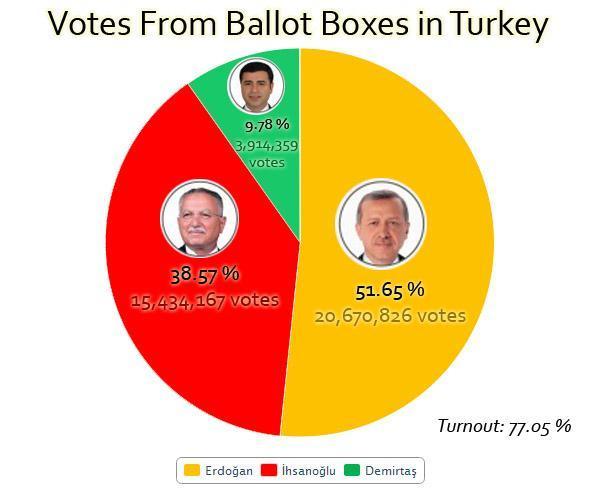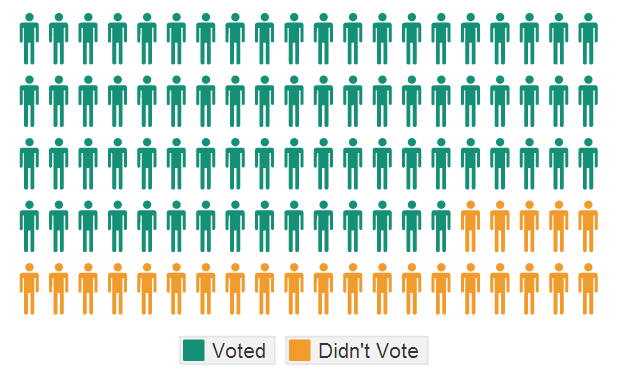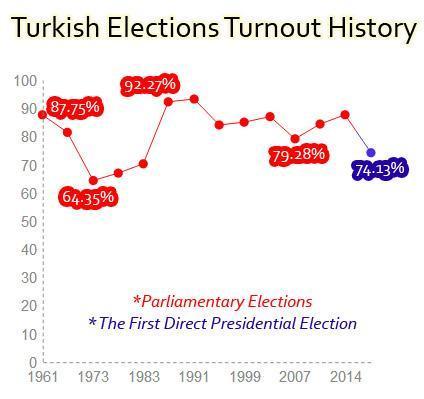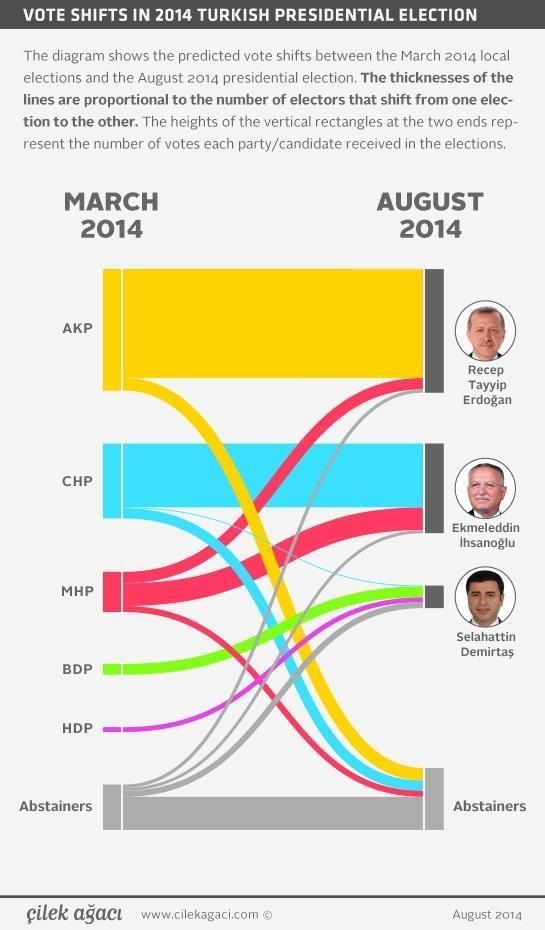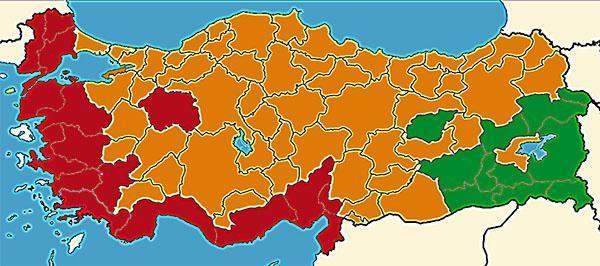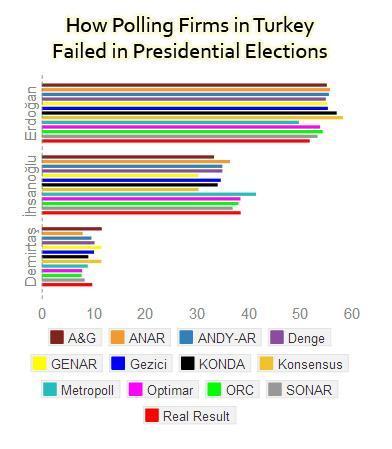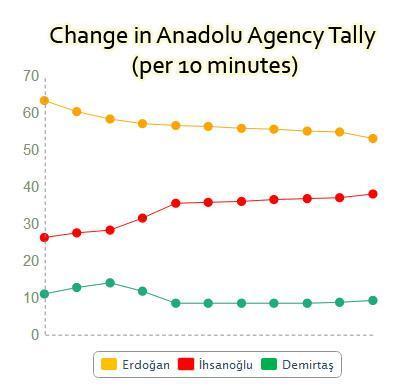EXPLAINED: Turkey’s presidential election results in a nutshell
Emre KIZILKAYA - ekizilkaya@hurriyet.com.tr
 Summary:
Summary:- This may be a Pyrrhic victory for Erdoğan.
- The biggest loser, undoubtedly, is the Nationalist Movement Party (MHP).
- The CHP could emerge stronger from its defeat if it succeeds in taking lessons and moving to transform itself.
- The real winner of the election is Selahattin Demirtaş, but not necessarily his party.
1) WHAT THE BASIC DATA SAYS
- According to the official results announced Aug. 15 by the YSK, 40,545,911 valid votes were cast, while 14,409,214 eligible voters did not go to the ballot box.
- Citizens cast their votes at voting centers inside Turkey, ballot boxes at border gates and voting centers abroad. Here are the official results:



 2) LOW TURNOUT
2) LOW TURNOUT
- Electoral participation rates are traditionally higher in Turkey compared to most European countries, but the most remarkable factor in the latest polls was the low turnout and its effect on the results. In Istanbul alone, more than 2.7 million voters did not go to the ballot box, and Erdoğan won the province by a margin of around 600,000 votes. The country’s first direct polls for president witnessed the lowest turnout figures since the 1977 parliamentary elections.
 3) BUT WHO DIDN’T VOTE, REALLY?
3) BUT WHO DIDN’T VOTE, REALLY?
- The voters of the main opposition Republican People’s Party (CHP) have been repeatedly accused of “not returning from their holidays” to vote for the former chair of the Organization of Islamic Cooperation (OIC), İhsanoğlu, whom many secular CHP voters disliked since their party nominated him jointly with the Nationalist Movement Party (MHP).

4) THE COLLAPSE OF ‘THE ROOF’
- As seen in the graph, 10 percent of AKP voters didn’t go to the ballot box, but Erdoğan easily compensated for that loss by attracting 28 percent of MHP votes, particularly in Central Anatolian provinces.
- Moreover, another 16 percent of MHP voters chose not to vote. 14 percent of CHP voters didn’t head to the ballot box, according to Çilek Ağacı, but those who voted overwhelmingly supported İhsanoğlu (85 percent).
- The post-election survey by Ipsos confirms the main arguments of these findings. Not only was the lowest turnout among MHP voters (72 percent), according to Ipsos, but also just 71 percent of MHP voters picked İhsanoğlu, while 27 percent opted instead for Erdoğan. Meanwhile, 86 percent of CHP voters picked İhsanoğlu and only 11 percent shifted to Erdoğan.
- Some 95 percent of those who voted for the AKP in the March 30 local elections voted for Erdoğan on Aug. 10. Wooing more than a quarter of the MHP voters was enough for Erdoğan to clinch victory in the first round despite the fact that a significant amount of AKP voters chosed to abstain from voting. According to Ipsos, most of the AKP and MHP voters who did not go to the ballot box said they did not vote because they were on holiday. The CHP’s non-voters were relatively fewer in number, but almost half of them said they did not go to the ballot box because they did not approve of İhsanoğlu.
5) THE USUAL MAP- While the MHP more or less disappeared with "the roof candidate," the CHP kept most coastal provinces (red), the People’s Democratic Party (HDP), which is focused on the Kurdish issue, dominated the southeast (green) and the ruling AKP won everywhere else (orange). So, once again, we have the election results map that we’ve know well since the early 2000s. Erdoğan gets 55 provinces, İhsanoğlu lags behind at 15, while Demirtaş scores 11.
 6) HOW BIG DID ERDOĞAN WIN?
6) HOW BIG DID ERDOĞAN WIN?
- Erdoğan’s goal was to win the elections in the first round, and he did so by faring better than his party scored in the last local polls. However, the fact that Erdoğan didn’t win by a greater margin may hamper him during his tenure as the country’s first directly elected president. Daily Hürriyet columnist Taha Akyol said the number of votes that Erdoğan obtained don’t give him a mandate strong enough to legitimately amend the Constitution, transforming the system to allow him exercise full presidential powers. AKP leaders, on the other hand, believe that they have a strong enough mandate to do it now, according to daily Cumhuriyet’s Ankara representative, Utku Çakırözer.
7) THE EMERGING ACTOR
- The real winner of the election is Selahattin Demirtaş, the HDP candidate. Although Demirtaş fell just short of the 10 percent threshold, it means that he increased his party’s votes from 2.7 million to more than 3.9 million by formulating a campaign that went beyond the Kurdish issue to embrace the problems of Turkey as a whole. In some western districts, Demirtaş doubled the HDP’s votes. But to repeat Demirtaş’s success, or even top it, will be a challenge for the HDP in the general elections.
8) SO WHAT? a) These results have the potential to trigger a paradigm shift in Turkish politics before the upcoming general elections. Erdoğan scored a decisive victory on a pro rata basis, but the number of votes he can win has seemingly maxed out. A revitalized opposition, particularly if it can compete with Erdoğan on a level playing field, could end the AKP’s domination.
b) The results also mark the end of nationalist politics in Turkey: The MHP has effectively been dissolved, the nationalist wing inside the CHP is about to be liquidated and the HDP has recognized that it will grow as much as it transcends Kurdish nationalism. These are all positive signs for a solution to the Kurdish problem.
c) The first trial with voting abroad failed. Out of 2,798,726 eligible voters abroad, only 232,795 cast their votes. The Erdoğan campaign was expecting 1 million extra votes from a total of 2 million votes cast abroad. How each party responds to this problem is likely to affect the outcome of the general elections.
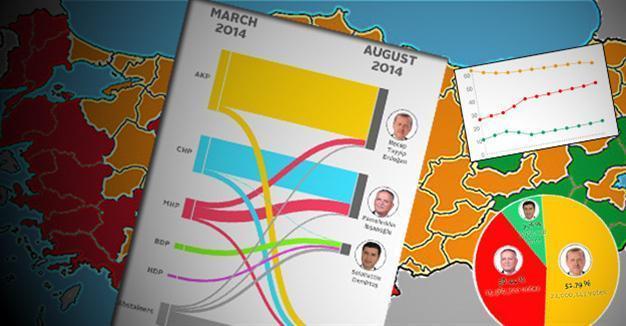 Summary:
Summary:

